OUT OF
NOWHERE ICE
SUDDENLY
SURROUNDED
THEIR WOODEN
FISHING
VESSEL.
They were
two miles
from shore,
yet the
turbulent
arctic
waters had
betrayed
them.
Captain
Ottamkoff
and his
fourteen
crew members
were not
even
supposed to
be here.
Eight days
before they
had set sail
on fair
winds from
the sleepy
northern
Russian port
of Mezen,
bound for
whaling
fishery
seasonal
settlements
of West
Spitzbergen.
But the
winds had
turned on
them and had
driven
towards less
hospitable
Edge Island
(Edgeøya or
East
Spitzbergen
-See
it on
Google Maps).
Now they
were trapped
by ice.
The
experienced
crew were no
fools. The
risks of
navigating
Arctic
waters were
deeply
understood.
They knew
their vessel
could be
crushed at
any time or
be freed to
open
waters. Consulting
the crew,
one sailor
remembered a
group of
Russians
several
years ago
had built a
hut on the
island in an
attempt to
start a
whale
fishery
there. It
was soon
decided that
if the hut
still
existed, the
crew would
stand a
better
chance by
wintering
there.
A party of
four was
formed under
the charge
of the
forty-four-year-old
boatswain
Aleksis
Khimloff.
The path
over the two
miles of
jagged ice
flow to
shore would
be a
treacherous
one. Ice
fragments
lifted with
the waves
and were
driven
against each
other by the
wind. The
sailors of
the
expedition
had to pack
lightly to
not impede
their
agility on
the tenuous
ice. An
axe, a
knife, a
small kettle
with a
cooking
grill, a
piece of
touchwood
and tinder
box since
the island
had no
trees, a bag
of twenty
pounds of
flour, and a
tin box of
tobacco
along with
their wooden
pipes, was
all the men
decided to
carry. The
danger of
polar bears
was always
front in the
minds of
arctic
seafarers
and a
musket,
powder horn
and lead
ball were
added to
their meagre
belongings.
There was
only enough
gunpowder
for twelve
shots, but
more than
sufficient
for their
overnight
journey to
find the
hut.

Greenland
Inuit
chasing
Walrus on
the
dangerous ice flow
by Francois Auguste
Biard
(WikiCommon)
While
challenging,
the
sure-footed
experience
of a sailor
proved a
boon and the
four men
crossed the
ice and
reached the
gravel shore
without
incident.
On the
backdrop of
a barren
wasteland,
the
protruding
hut was
quickly
discovered
only a half
a mile from
the sea.
Though
weathered,
the previous
occupants
had built a
sound
structure.
Wood had
been brought
from Russia
and a
traditional
peasant
dwelling had
been built.
The
structure’s
main
rectangular
room was 36
feet by 18
feet. It was
18-foot high
to allow
a high-pitched
roof to
deter snow
build up. A
chimney-less
clay
fireplace
had been
built. Small
trap-door
like windows
in the upper
part of the
walls
allowed for
the smoke to
vent. It
proved an
efficient
system of
keeping the
lower part
of the room
smoke-free.
Typically,
these
fireplaces
were built
like brick
ovens with
flat tops.
Peasants
sometimes
slept on top
of them to
benefit from
the warmth
of the stone
and clay.
To guard the
main room
from the
frigid
arctic air,
an enclosed
porch or
antechamber
had been
built at the
entrance.
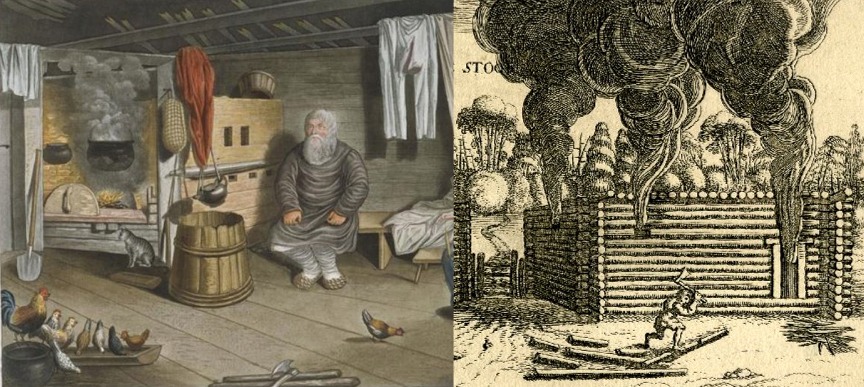
Left is a
Russian
inferior
with
fireplace (kurnaya).
Right is a
17th century
print
illustrating
how smoke
escaped. (WikiCommon)
The four
sailors were
delighted
with what
they had
found. Though there
were gaps in
the plank
walls and
strong winds
blowing
outside, the
group was
still able
to pass the
night
tolerably in
the hut. Early the
next morning Aleksis and
his men
hurried back
to the ship
to tell the
crew the
good news.
Reaching the
shore, they
were greeted
by an empty
horizon.
The ship was
gone. The
ice flow had
also
disappeared
leaving only
open water.
Little did
the four
sailors
know, the
ship with
its crew had
been claimed
by the
depths of
the Arctic
Ocean.
Stranded, Aleksis
and his men
faced a
bleak
situation. After a
dozen shots,
the musket
would be
useless. There were
no trees or
bushes or
even grass
on the
island. How
would they
keep warm?
Only moss
grew in any
abundance on
the barren
tundra that
was now
their home.
While there
were herds
of
reindeers,
the
surrounding
waters
seemed
devoid of
fish.
Without
fish, there
were no sea
mammals.
With
reindeer as
they only
source of
food, how
would they
hunt when
without a
musket?
With Aleksis
was his god
son, Ivan,
who had
wintered at
the whaling
settlement
on West Spitzbergen.
They had
experience
living with
limited
resources.
However,
without fuel
or weapons
to hunt,
they were
doomed.
The Search
for Fuel and
Food
With no
trees, the
castaways
set about
combing the
beaches for
driftwood to
fuel their
fire.
They were in
luck.
Washed up on
the
extensive
shoreline of
Edge Island
were pieces
of wood from
the distant
mainland or
from
shipwrecks.
Collecting
driftwood
and hauling
it back to
the hut
became a
priority
since winter
snows would
soon make
the search
impossible.
The musket
was
immediately
put to work
downing
reindeer to
build up a
food stock.
With the
gunpowder
expended,
finding a
way to hunt
became the
next
priority.
Also they
were now
almost
defenceless
from a polar
bear attack.
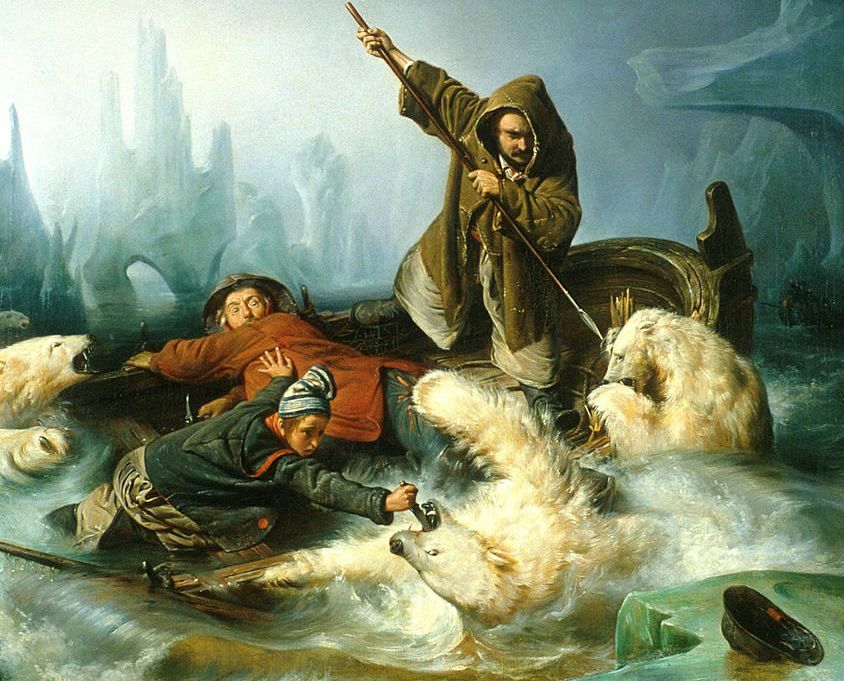
Whaling
fishermen
attacked by
polar bears
off the
coast of
West
Spitzbergen
by Francois
Auguste
Biard (WikiCommon)
As their
stock of
reindeer
meat began
to dwindle,
the men grew
desperate
for a
solution to
hunt more
food. The
indigenous
Sami
(Laplanders)
of northern
Scandinavia
used lassos
to catch
reindeer but
the sailors
had no rope.
Reindeer were
too skittish
to kill with
an axe or
club. The
permafrost
and the fact
they lacked
excavating
tools
negated the
option of
digging pits
to trap
them. Weapons were
needed.
Continuing
to scour the
beaches, their
luck changed
for the
better when
one sailor
discovered a collection
of boards
with iron
hardware
attached to
them. Though
the find was
evidence of
some ship
that meet it
demise by
unforgiving
ice of the
Arctic, it
was a
salvation to
the stranded
men.
Part of the
iron
hardware was
a thick hook
that was
heated, bent and
attached to
a wooden
handle to
form a
hammer.
With a stone
as an anvil,
they set
about
forging the
remaining
iron
hardware
into two
spear heads.
These they
polished and
sharpened
with stones
then mounted
the
spearheads
with strips
of reindeer
skin onto
long pieces
of
driftwood.
Now armed
with two
crude
lances, it
was time to
go pick a
fight.
Since the
spears were
too clumsy
to throw at
reindeer,
they were
left with
little
choice for
food, but to
take on a
polar bear.
One can only
imagine the
fear they
felt facing
down what
they saw as
a ruthless
monster.
However it
was four
against one
and the
sailors
triumphed
over the
bear.
To the men,
bear meat
seemed
tastier than
the that of
the
reindeer.
However it
was the
bear's
sinews
(tendons)
that proved
the greatest
discovery.
The sinew
was
divisible
into
threads.
Carving a
curved
driftwood
root and
attaching
the sinew,
the
castaways
had built a
bow.
The scraps
of leftover
iron
fragments
were
hammered
into
arrowheads.
Shafts were
made from
washed up
fir branches
and feathers
were found
from arctic
water fowl.
Now they
could hunt
reindeer.
They hunted
with great
success.
However
scarcity of
wood made
cooking
their meat
impossible.
The hut's
oven-like
fireplace
was designed
to keep them
warm, not
cook their
food.
Initially
the sailors
were forced
to consume
their meat
raw.
Soon they
thought of a
solution of
drying the
meat on
wooden pegs
in the roof
of their
hut. The
meat was
exposed all
summer long
to the sun,
fresh air
and wind,
like they
were drying
cod but
without the
luxury of
salt.
Hanging meat
outside
their hut
must have
caused more
run-ins with
the dreaded
polar bear
population.
They never
risked
hunting them
again but in
defence, the
castaways
were forced
to battle
and kill
nine more
polar bears.
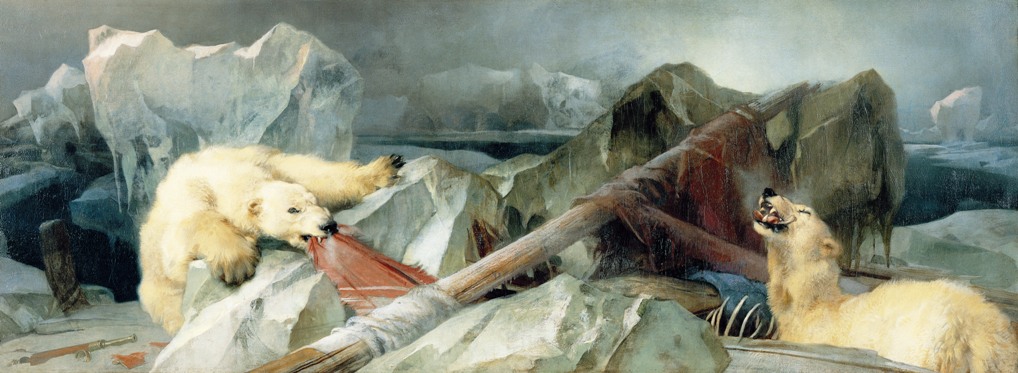
"Man
proposes god
disposes."
by Edwin
Henry
Landseer,
1864 (Wiki)
Supposedly a
reference to
Franklin's
Lost Arctic
Expedition.
Surviving
Scurvy
Scruvy was
sailor's
greatest
enemy in the
northern
reaches of
the world.
Scurvy is
caused by a
deficiency
in Vitamin C
in a
person's
diet.
Prolonged
lack of
Vitamin C
eventually
causes
fever,
delirium,
tooth loss,
jaundice,
internal
haemorrhaging,
convulsions,
organ
failure, and
death.
On a barren
Arctic
island,
where could
they find
enough
Vitamin C to
survive?
First they
searched
gravel
beaches for
scurvy-grass.
This
white-flowering
plant is
packed with
Vitamin C
and could be
dried for
use in
winter.
But their
foraging
effort bore
like
success.
What they
found was
not enough
to sustain
them.

Cochlearia
officinalis,
or
Scurvy-grass.
In
Scandinavia
it grows on
gravel
beaches and
crevices of
beach
cliffs.
(Wiki)
Again Ivan's
experience
on
West Spitzbergen
proved a
boon to the
group
surviving.
Ivan told
them of the
necessity of
consuming
reindeer
meat raw,
and drinking
blood from
freshly
killed
reindeer
while it was
still warm
to stave off
scurvy.
Realistically
it would
have taken
vast
quantities
of blood
daily to get
enough
Vitamin C
for them to
survive.
However the
raw meat had
enough
vitamin C to
keep scurvy
at bay, if
you could
stomach it.
But one of
their band
could not.
Drinking the
blood made
him sick,
and
consuming
raw meat did
not provide
him enough
of the
precious
vitamin.
Likely
suffering
from a
digestive or
absorption
disorder,
the
heavy-set
crew member
slowly
weakened
from scurvy,
eventually
becoming
bed-ridden.
For a year
the other
three nursed
their
comrade like
a new-born
child until
he finally
succumbed.
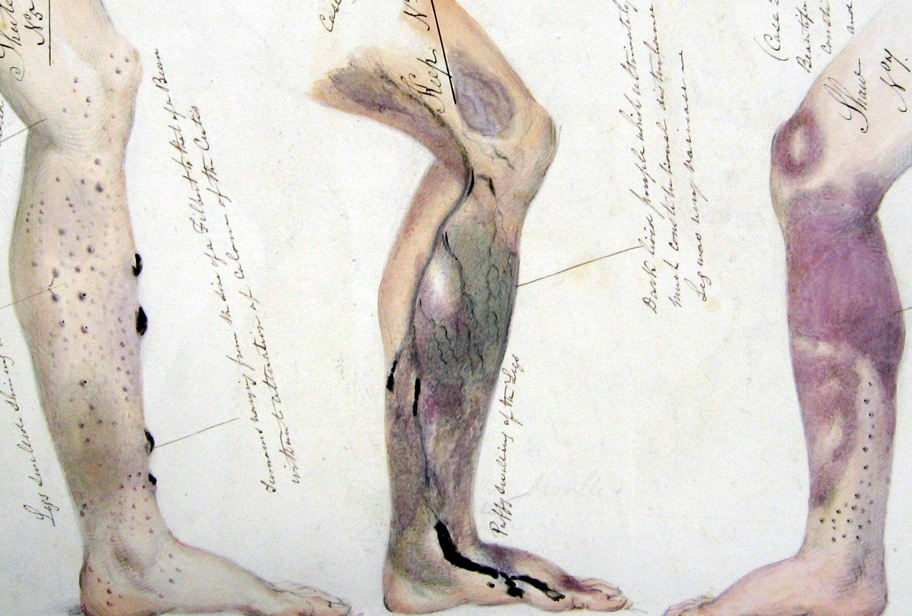
Illustration
of Scurvy
damage to
the leg on
Convicts by
Surgeon
Henry Walsh
Mahon, 1841
(The
National
Archives
(UK) in
Wiki)
Arctic
Darkness
At the end
of October,
Edge Island
was plunged
into
darkness.
Humans were
not meant to
live there.
Without
candles and
with scant
quantities
of wood to
keep warm,
the
castaways
faced a
three-month
nocturnal
life,
equivalent
to
blindness.
Determined
not to be
without
light, the
discovery of
clay on the
island was
hoped to be
a solution.
From their
hunting, the
sailors had
large
quantities
of reindeer
fat. If they
could make a
clay
bowl-like
lamp, they
could beat
back the
night.
From their
thread bare
clothing
they tore a
thin strip
of twisted
linen to
make a wick.
The clay was
formed into
bowl and the
wick and fat
were added.
Unfortunately
when lit the
clay warmed
and became
porous,
allowing the
warmed fat
to leak out
its sides
and bottom.
Undeterred,
the next
clay lamp
was air dyed
and heated
red shot in
a fire.
They then
cooled it
with some of
their
remaining
flour, which
leached
starch into
pores of
clay like a
rudimentary
glaze.
To seal it
further from
leaking,
they dipped
strips of
linen cut
from their
shirts in a
flour paste
and wrapped
them around
the outside
of the clay
bowl.
To their
great joy,
it was a
success!
A small
quantity of
hemp cord
from a
shipwreck
was found on
the shore
and provided
them with
enough wick
to have the
lamp burn
for as long
as they were
on the
island.
Darkness had
been beaten
back.
Fending
off
Nakedness
Their
clothing on
their backs
was in
tatters.
Throughout
their time
on the
island they
were
industrious
in tanning
the hides of
the reindeer
they killed
by rubbing
melted fat
into the
hide's
pores.
Leather was
to be the
cloth.
Animal sinew
provided the
thread.
All that was
missing to
make hide
clothing was
a needle to
sew them
together.
They set
about
foraging a
needle which
proved
challenging.
To make the
eye of the
needle they
drove the
pointed
blade of
their knife
into flat
end of the
needle.
It worked.
However
needle's eye
had jagged
edges that
cut the
sinew thread
often making
the process
of sewing
long and
tedious.
In the
summer they
wore
hairless
buckskin
clothing
while in the
winter they
donned long
fur frocks
with hoods
that closed
to protect
their faces
and necks.
Six
Long Years
For six long
years the
three
castaways
survived.
Each winter
the snow
piled up
around their
hut so high
they had to
cut an exit
trap door in
their roof.
The cold
dark days of
winter
ticked
slowly by
the light of
their clay
lamp while
they choked
down small
raw or
frozen
chunks of
meat.
Their flour
long gone,
they lived
only on the
meat of
deer, fox
and bear.
An inventory
of animal
hides piled
higher and
higher in
the fading
hopes of
being saved
and
profiting
from their
enterprise
while
imprisoned
in the
Arctic.
While on the
island they
had hunted
down over
two hundred
and fifty
reindeer.
They had
buried one
of their
friends.
Did they
think it was
only a
matter of
time before
the Arctic
would claim
their lives
as well?
After six
years and no
sign of
rescue, hope
must have
become as a
rare as a
tree on Edge
Island.
On August
11, 1749 a
vessel
appeared on
the horizon.
A Russian
ship had
been pushed
by contrary
winds
towards the
shores of
Edge Island.
The
castaways
jumped into
action.
Visually
they were
mere specks
on the
island's
barren
landscape
and could
never be
seen.
So they ran
and ignited
signal fires
they had
prepared on
nearby hills
for such an
event.
Hoisting a
reindeer
hide, they
waved it as
a sign of
distress.
To their
unimaginable
joy, the
vessel's
crew saw the
commotion
made by the
castaways
and anchored
to
investigate.
Though
castaways,
the still
had to
negotiate
with the
Russian
captain for
passage
home.
Happily a
deal was
struck and
all the
deer, fox
and bear
hides, 2000
lbs of
reindeer
fat, all
their sparse
belongings
including
the tools
that saved
their lives
were loaded
on board. On
September 28
they arrived
home. On her
hearing of
the news,
Aleksis
Khimloff's
wife rushed
to the dock
to meet her
long-thought-dead
husband.
The meeting
almost ended
in tragedy,
when Aleksis'
wife fell
into the
water, but
was rescued.
Their
incredible
story spread
through
Northern
Russia.
However the
men had come
back
changed.
A six-year
protein-rich
diet of
reindeer
meat had
left them
unable to
stomach
bread or
alcohol.
Eating other
foods also
proved a
challenge.
The
castaways
were
interviewed
by Professor
Le Roy of
the Imperial
Academy at
St.
Petersburg,
and, after
being
convinced of
its truth,
published
this amazing
story of
survival in
the Arctic.
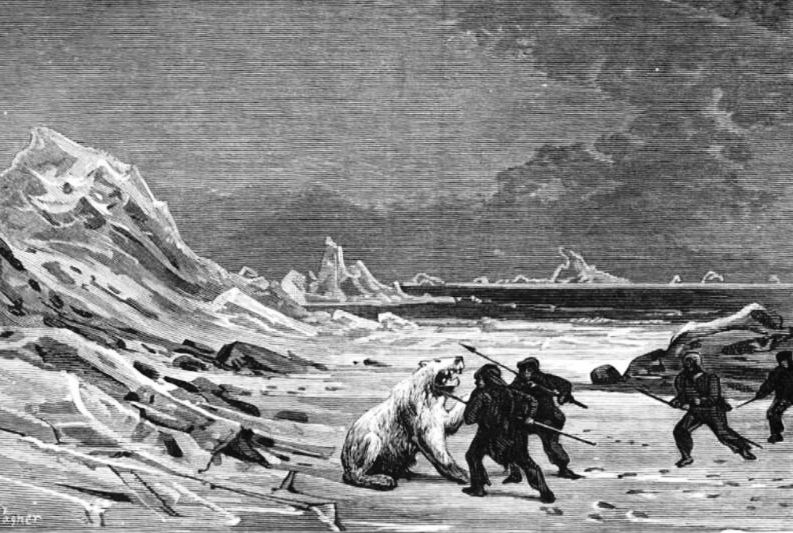
Castaways
fighting
their first
Polar Bear
(from
Stories of
Enterprise...
1874)